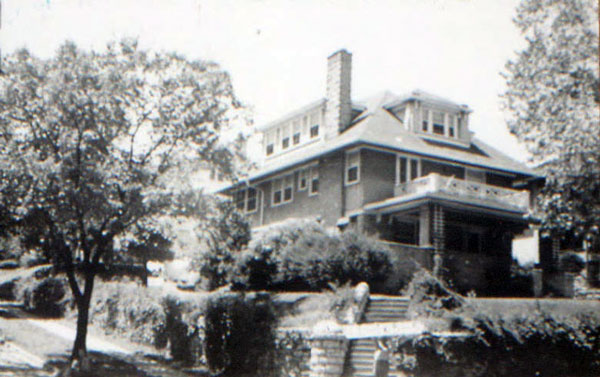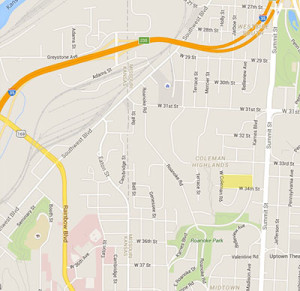
This area of Coleman Highlands at W. 34th Street and Karnes Boulevard looks much as it did when it was developed in the early 20th century.
The Coleman Highlands block that is the focus of this week’s look back in history is a peaceful residential area, part of a historic district developed in the early 20th century.
 While some Midtown blocks bustled with commercial activity or housed well-known or well-to-do Kansas Citians, many blocks Midtown, like this one, were made up of comfortable homes built for white-collar, middle and upper class folks. According to the Coleman Highlands local historic register listing, Coleman Highlands was one of those.
While some Midtown blocks bustled with commercial activity or housed well-known or well-to-do Kansas Citians, many blocks Midtown, like this one, were made up of comfortable homes built for white-collar, middle and upper class folks. According to the Coleman Highlands local historic register listing, Coleman Highlands was one of those.
“Residents included physicians, salesmen, clerks, grocers, small business owners, teachers, restauranteurs and saloon keepers, accountants, and the like, many of whom worked downtown or in the West Bottoms.”
As part of our Uncovering History Project, the Midtown KC Post is taking a look at the 1940 tax assessment photos of each block in Midtown. This week we’re focusing on a block of Coleman Highlands from 33rd Terrace south to 34th Street, and Coleman Road east to Karnes Boulevard. (Many people seem confused by the tax assessment photos, which all include a man holding a sign. Here’s the story behind them).
The neighborhood was undeveloped until 1907, but when the Coleman farm property became available, “it was in the perfect location to capitalize on demand” for homes. New residents could get to and from Coleman on the streetcar. The area was also up on a high bluff, offering fresh air and cool breezes.
Coleman is significant in several ways. First, its streets are not laid out on a square grid pattern, like many blocks of Midtown. Instead, developers followed the natural curves of the land, “enhancing the rural, healthful qualities of the neighborhood,” the historic register document says.
Secondly, the neighborhood offers “an excellent cross section of the styles and forms of residential construction popular in Kansas City during the first quarter of the 20th century. Simple Kansas City Shirtwaist foursquares and bungalows are adorned with elements of Craftsman, Colonial Revival, Neoclassical and Tudor architecture. Strong examples of Prairie Style, Craftsman, and romantic revival (Tudor, Chateauesque, etc.) designs are present.”
Limestone foundations were widely used in construction in Coleman Highlands like many other Midtown neighborhoods.
The slideshow below shows the homes that stood on this block in 1940.
Historic photos courtesy Kansas City Public Library/Missouri Valley Special Collections.
Do you have memories or more details about this area of Midtown? Please share them with our readers.
Would you like us to focus on your block next week? Send us an email.
Our book, Kansas City’s Historic Midtown Neighborhoods, is available now. Let us know if you want us to come to your neighborhood association or organization’s meeting to share what we’ve learned about Midtown neighborhood history and tell your members how they can help preserve Midtown history. If you’d like to order the book, email Mary Jo Draper at mjdraper@midtownkcpost.com.
[slideshow_deploy id=’24772′]



I grew up in the 3100 block of Coleman road. Lots of fond memories. I remember watching the flood of 1951 from the bluff at the end of 32nd st. We had to evacuate the area when the oil tanks started sailing down southwest blvd. they were afraid they would explode